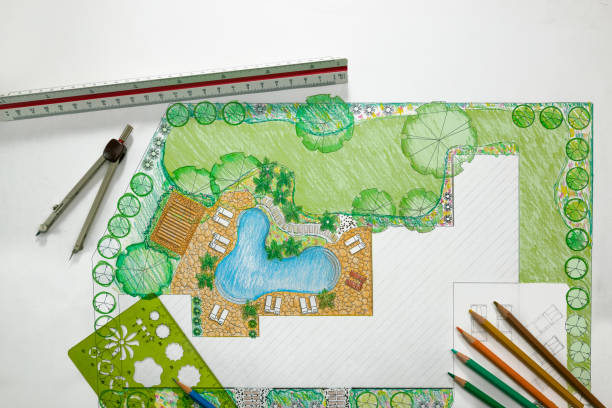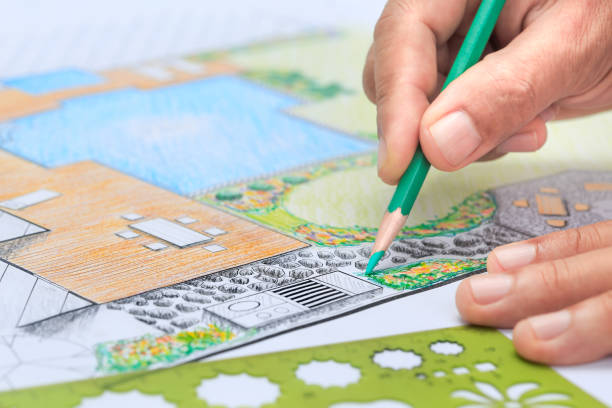Nature is a powerful force that shapes our external environment and positively impacts our internal well-being. With careful planning and design, we can cultivate natural landscapes around our homes and commercial spaces that improve livability while protecting local ecologies. This article will outline a step-by-step process for professional landscape planning that considers both functional and aesthetic needs.

We’ll explore how to conduct site assessments, develop concept designs, source plants, and materials, and implement plans to transform empty yards or spaces into thriving natural habitats. Whether you’re designing for a residential property or commercial complex, following industry best practices can help ensure your landscape vision becomes a reality that sustains itself with minimal ongoing maintenance while continuing to provide benefits for local wildlife and people for years to come.
Start With A Plan
Before starting any landscape project, it’s essential to have a plan. Creating a blueprint of your vision allows you to think through the design elements needed for success and find potential flaws before they become costly. The first step in professional landscape planning is identifying goals that align with your personal or company values.
Are you looking to create a private backyard oasis for relaxation and entertainment or a public green space to enhance community well-being? Do you want to attract specific wildlife, reduce water usage, or incorporate sustainable design features? Identifying these goals will guide the rest of your planning process.
Consider Layout and Functionality
When designing your landscape, it’s crucial to consider both layout and functionality. The layout refers to the physical arrangement of elements within your landscape, while functionality considers how those elements will be used and interact.
A well-designed landscape should have a natural flow for easy movement and access. It is essential when creating pathways or incorporating features like seating areas or outdoor kitchens. It’s also necessary to consider how plants and structures interact, considering factors like sun exposure and water needs. For example, you’ll want to ensure outdoor planters are placed in the right location and have proper drainage to thrive.
Select Plants Suited To the Climate and Conditions
One of the most critical and fundamental aspects of landscape planning is carefully selecting plants well-suited to your area’s unique climate and site conditions. This thoughtful consideration guarantees a visually pleasing landscape, fosters optimal plant health, and significantly reduces the overall maintenance requirements.
By conducting thorough research on the plants that thrive specifically in your region, you will be equipped with valuable knowledge to make informed decisions when choosing the perfect species for your landscape. Consider essential factors such as water requirements, sun exposure levels, and soil quality to ensure that your plant selection aligns perfectly with your outdoor space’s specific needs and characteristics.
Arrange Plants for Visual Appeal
While functionality and sustainability are essential considerations in landscape planning, the overall aesthetic appeal should be noticed. When arranging plants, consider their color, texture, and height for a visually appealing design.
Grouping plants of similar colors can create a calming effect, while contrasting textures can add dimension to your landscape. Also, incorporate different heights to create depth and visual interest. For example, tall trees and shrubs in the background can provide a backdrop for smaller flowers and ground cover in front.
Factor in Ongoing Care Requirements
Aside from the initial design and installation, ongoing maintenance is crucial to a thriving landscape. When planning your landscape, it’s essential to consider the long-term care requirements of each element.
Consider factors such as different plants’ pruning needs, watering schedules, and fertilization requirements. If you’re incorporating hardscaping elements like retaining walls or water features, factor in any necessary upkeep, such as sealing or cleaning. Proper planning can minimize future maintenance costs and ensure your landscape thrives for years.
Address Lighting, Watering, and Other Functional Details
In addition to the layout and plant selection, other functional details should be considered in landscape planning. Lighting is essential, especially for outdoor spaces intended for evening use. Strategically placed lighting provides safety and security and enhances the visual appeal of your landscape design.
Watering systems should also be carefully planned to ensure proper plant hydration without wasting resources. Features like rain gardens or drip irrigation can reduce water usage while benefiting the environment.
Other functional details include drainage systems, seating areas, and garden tools and equipment storage options. Addressing these active elements in the planning stages ensures a seamless integration into your landscape design that meets aesthetic and practical needs.
Consult Professionals as Needed
While planning and implementing a landscape project independently is possible, consulting with professionals can provide invaluable expertise and guidance. Landscape architects, designers, and contractors have knowledge and experience that can help turn your vision into a reality while avoiding common pitfalls.
In addition, professionals can offer advice on the best plants and materials to use and incorporate sustainable design practices. They can also help with the logistics of obtaining necessary permits and coordinating subcontractors.
Conclusion
A well-planned landscape enhances the visual appeal of your outdoor space and provides numerous benefits for local wildlife and people. By starting with a plan, considering layout and functionality, selecting appropriate plants, arranging for visual appeal, factoring in ongoing care requirements, addressing functional details, and consulting with professionals, you can create a sustainable and aesthetically pleasing landscape that meets your needs and goals.
Published by HOLR Magazine.


